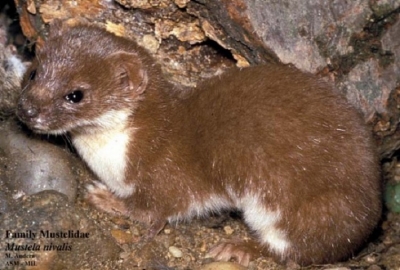Least Weasel, Mustela nivalis
The Least Weasel, which is the smallest carnivore in North America, can be found in the middle and eastern areas of the state. They are very secretive and wary, but also very aggressive.
Description: A small mammal with a long, slender body, short legs, flattened head, and a long neck. Their tails are short, ears are rounded and short, whiskers are prominent, and eyes are black. The soft, dense fur coats are brown above and white below, including the chin and feet. The tail is all brown.
Length: 6 - 9.8 inches
Tail: 0.8 - 1.5 inches
Ears: 0.4 inches
Weight: 1.25 - 2.0 ounces
Similar Species: Long-tailed Weasel is larger and has a longer, black-tipped tail.
Habitat: Least Weasels can be found in a wide variety of habitats, but prefer forests and woodlands with rocky slopes. They also occur in grasslands, brushy fields, marshy areas, and edge habitats . Least Weasels occupy, and build nests of grass, in old mole burrows or other holes in the ground.
Diet: Least Weasels primarily feed upon mice and other small mammals. They will also eat insects, lizards, and birds and their eggs.
Breeding information: Breeding occurs primarily from spring through fall. Females may have 2 or more litters per year after a gestation period of 34-37 days. The litter size ranges from 1-7, but averages 3-5 young. Newborns are pink, hairless, toothless, and eyes and ears are closed. Teeth begin to emerge by 11 days. At 6 weeks old they are able to make their first kill and become weaned.
Status in Tennessee: Least Weasels are uncommon in the state. They are Deemed in Need of Management by Tennessee Department or Environment and Conservation.
Fun Facts:
- Northern populations have a winter coat that turns all white, but the Least Weasels here in Tennessee retain the brown color on the back all year.
- They eat the head and brains of their prey first.
